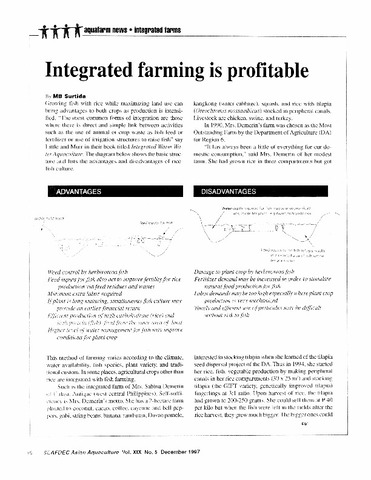Integrated farming is profitable
| dc.contributor.author | Surtida, Marilyn B. | |
| dc.date.accessioned | 2013-11-28T08:51:28Z | |
| dc.date.available | 2013-11-28T08:51:28Z | |
| dc.date.issued | 1997 | |
| dc.identifier.citation | Surtida, M. B. (1997). Integrated farming is profitable. SEAFDEC Asian Aquaculture, 19(5), 16–17, 31. | en |
| dc.identifier.issn | 0115-4974 | |
| dc.identifier.uri | http://hdl.handle.net/10862/1777 | |
| dc.description.abstract | Growing fish with rice while maximizing land use can bring advantages to both crops as production is intensified. Details are given of the basic structure of rice field aquaculture, listing the major advantages and disadvantages of this system. Particular reference is made to the integrated farms at Culasi, Antique (Western Philippines) and at Barangay Igcocolo, Guimbal, Iloilo where agricultural crops other than rice are integrated with fish farming (tilapia -- Oreochromis mossambicus) and livestock rearing. An account is also given of the system at the AQD site at New Busuang, Kalibo, Aklan which evaluates the economic feasibility and profitability of farming mudcrab in tidal flats with existing mangroves. | en |
| dc.language.iso | en | en |
| dc.publisher | Aquaculture Department, Southeast Asian Fisheries Development Center | en |
| dc.subject | Oreochromis mossambicus | en |
| dc.subject | Philippines | en |
| dc.title | Integrated farming is profitable | en |
| dc.type | magazineArticle | en |
| dc.citation.volume | 19 | |
| dc.citation.issue | 5 | |
| dc.citation.spage | 16 | |
| dc.citation.epage | 17, 31 | |
| dc.citation.journalTitle | SEAFDEC Asian aquaculture | en |
| dc.subject.asfa | agropisciculture | en |
| dc.subject.asfa | aquaculture systems | en |
| dc.subject.asfa | crab culture | en |
| dc.subject.asfa | fish culture | en |
| dc.subject.asfa | ricefield aquaculture | en |


